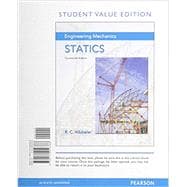Engineering Mechanics: Statics excels in providing a clear and thorough presentation of the theory and application of engineering mechanics. Engineering Mechanics empowers students to succeed by drawing upon Professor Hibbeler’s everyday classroom experience and his knowledge of how students learn. This text is shaped by the comments and suggestions of hundreds of reviewers in the teaching profession, as well as many of the author’s students.
The Fourteenth Edition includes new Preliminary Problems, which are intended to help students develop conceptual understanding and build problem-solving skills. The text features a large variety of problems from a broad range of engineering disciplines, stressing practical, realistic situations encountered in professional practice, and having varying levels of difficulty.
Also Available with Mastering Engineering -- an online homework, tutorial, and assessment program designed to work with this text to engage students and improve results. Interactive, self-paced tutorials provide individualized coaching to help students stay on track. With a wide range of activities available, students can actively learn, understand, and retain even the most difficult concepts. The text and MasteringEngineering work together to guide students through engineering concepts with a multi-step approach to problems.
NOTE: This loose-leaf, three-hole punched version of the textbook gives you the flexibility to take only what you need to class and add your own notes — all at an affordable price. For loose-leaf editions that include MyLab™ or Mastering™, several versions may exist for each title and registrations are not transferable. You may need a Course ID, provided by your instructor, to register for and use MyLab or Mastering products.
If you would like to purchase both the loose-leaf version of the text and Mastering Engineering, search for:
0135841224 / 9780135841228 Engineering Mechanics: Statics, Loose-Leaf Edition, plus Mastering Engineering with Pearson eText -- Access Card Package, 14/e
Package consists of:
- 0134056388 / 9780134056388 Engineering Mechanics: Statics, Loose-Leaf Edition, 14/e
- 0135681987 / 9780135681985 Mastering Engineering Revision with Pearson eText -- Standalone Access Card -- for Engineering Mechanics: Statics & Dynamics








